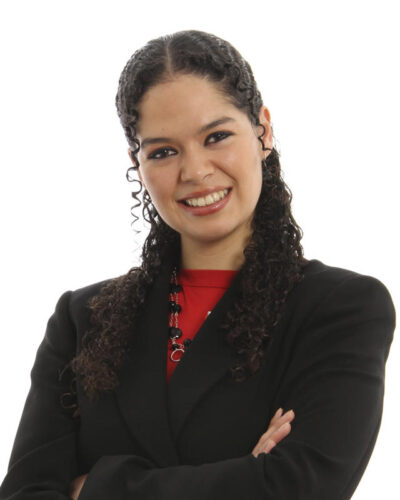Innovation and STEM Fields
For America to compete in the 21st century, we need a robust innovation economy—which requires a workforce skilled in the science, technology, engineering, and math (or STEM) fields. Yet American students are not entering those industries in sufficient numbers, and the United States is projected to face a shortage of one million STEM workers by 2022.1 Foreign-born students frequently gravitate towards STEM disciplines, making up roughly one out of every three individuals earning graduate-level STEM degrees each year. Our broken visa system, however, makes it difficult for many of them to stay after graduation—a reality that hurts the ability of our employers to expand and create more opportunity for American workers. 1 President’s Council of Advisors on Science and Technology, "Engage to Excel: Producing 1 million Additional College Graduates with Degrees in Science, Technology, Engineering, and Mathematics," February 2012. Available online.

Latina Entrepreneur Says Immigrants Play an Important Role Filling STEM Positions
Laura Sanchez, one of a tiny number of Latinas who own IT companies in the Chicago area, is proud to be a link between Chicago’s STEM (Science, Technology, Engineering, and Mathematics) and Hispanic communities. Sanchez was born in Mexico got her degree from Tec de Monterrey, a school she… Read More

Purdue Professor Says Our Economy Suffers When Talented International STEM Grads Are Forced to Leave
Professor Gerhard Klimeck is a master of the Conte, a huge supercomputer based in Indiana. Rippling with copper wire, Conte is capable of running the sort of design simulations that are responsible for our smaller and sleeker iPhones. Klimeck works in the cutting-edge field of nanotechnology, but he grew… Read More

This Manufacturing Giant Didn’t Leave, But it Needs More Immigrant STEM Workers to Stay in the Country and Succeed
Jennifer Sharp has an unusual title for an engineering company: Immigration Specialist. Her company, Schweitzer Engineering Laboratories (SEL), designs and manufacturers products that protect power grids around the world. It is one of the largest employers in southeast Washington state, with 2,600 employees at its Pullman headquarters and 4,500 employees… Read More

New American Economy on the Protect and Grow American Jobs Act
CONTACT Sarah Roy, New American Economy, [email protected] “This bill takes an important step toward updating the H-1B visa program to help ensure that companies are hiring foreign talent for their skills and expertise and not for wage reasons. We support this effort, and call on Congress to reform our… Read More

Advancing the Pittsburgh Region
New American Economy (NAE) has released a research brief that highlights the economic and demographic contributions of immigrants in the Pittsburgh region. The brief shows that the 10-county Pittsburgh region’s 82,308 immigrant residents have a significant positive impact on southwestern Pennsylvania’s economy through high rates of workforce participation… Read More

Weekend Reading: Highlights from this week’s immigration news (July 4-8)
Just about every day in towns and cities across America, immigrants are becoming naturalized citizens. But what is it like to pledge allegiance to America and become a U.S. citizen on July 4, our nation’s birthday? Vice’s Serena Solomon writes about the unique experience here. This week in… Read More

From Experience, Doctoral Student Knows More Immigrants Would Love the Chance to Study, Work, Pay Taxes
When Mariana Ocampo was growing up in Texas, she and her siblings longed for part-time jobs similar to the ones their teenage friends held. They wanted to work, they wanted to spend their earnings, and they wanted to contribute to their family. But since Ocampo and her siblings… Read More

Miss Michigan 2016 Just Happens to Be an Automotive Designer–and a Chinese Immigrant
This summer, Arianna Quan was crowned Miss Michigan — but the 23-year-old, who aspires to be an automobile designer and is paying for her studies with the tens of thousands of dollars she’s won from competing with the Miss America Organization, didn’t have a typical “Toddlers & Tiaras” upbringing. Quan,… Read More

From Flea Markets to International Board Rooms, Malaysian American Epitomizes Immigrant Entrepreneurship
“My mom always encouraged me to be entrepreneurial,” says serial entrepreneur and angel investor Cheryl Yeoh. As a teenager in Malaysia, Yeoh would sell inventory from her mother’s catalogue company to local corporations and set up flea markets during school holidays. “I learned a lot about sales, negotiations,… Read More

This Peoria-Based Doctor and Medical Professor Sees Everyday How Immigrants Help Her Community Thrive
Between 1971, when Dr. M. Miller joined the faculty of the newly opened University of Illinois College of Medicine in Peoria, Illinois, and today, she has seen the city’s foreign-born population more than double. She attributes much of the area’s economic success to their contributions. On a personal… Read More
Outsize Role in the Workforce
Immigrants punch above their weight class in the STEM fields, making up far larger portions of the STEM workforce than they do the U.S. population overall. This dynamic is particularly pronounced in several states. In New Jersey, for instance, immigrants make up almost two out of every five STEM workers, while accounting for only one in five of the state’s residents.
States with the Highest Share of Foreign-Born STEM Workers, 2014
Labor Shortages
In recent years, many U.S. employers have struggled to find enough STEM workers. This lack of manpower has real consequences for the economy—making it difficult for firms to expand and create jobs for American workers at all skill levels. In several specialized fields, like physical science and software development, the unemployment rates of U.S.-born STEM workers are particularly low, indicating there are simply not enough U.S.-born workers to meet the needs of employers.
Take a look at our latest research about the shortage of STEM workers.
U.S. Citizen Unemployment Rates in STEM Fields Most Heavily Reliant on Immigrant STEM Workers, 2014
Earning STEM Degrees
International students make up a large share of STEM graduate students. In 2014, more than a quarter of STEM master’s degrees and more than a third of STEM Ph.D. degrees went to students in the country on temporary visas. Meanwhile, the number of American citizen and permanent resident students pursuing graduate degrees in science and engineering fields actually fell by 6.3 percent between 2010 and 2013.2 Our broken immigration system means that many of these international students will struggle to remain in the country after graduation, despite employers needing them.
Sources:
2 National Science Foundation, Science and Engineering Indicators, 2016, Appendix Table 2-25. Available online.
Share of Ph.D.'s in Selected Fields Going to Students on Temporary Visas, 2014
States Graduating the Most STEM Students on Temporary Visas, 2014
States Needing STEM Workers
While every state was short STEM workers in 2015, the shortage was particularly acute in North Dakota and South Dakota, where employers listed 87 and 71 STEM positions, respectively, for each unemployed STEM worker. These are gaps that immigrants could help fill. In South Dakota, for instance, immigrants made up just three percent of all STEM workers in 2015, one of the lowest shares in the country.
States with Greatest Shortages of STEM Workers, 2014
Creating U.S. Jobs
Rather than reduce the number of jobs available to American workers, foreign-born STEM graduates often create additional jobs for U.S.-born workers. Research shows that when a state gains 100 foreign-born STEM workers with graduate-level training from a U.S. school, an average of 262 jobs are created for U.S.-born workers there in the seven years that follow.3 More specifically, the temporary visa (H-1B) program for high-skilled workers is also linked to job creation for American workers and economic growth. However, the current system fails not only to provide visas that companies need to grow, but also to protect against fraud and abuse.
Sources:
3 Madeline Zavodny, “Immigration and American Jobs,” The Partnership for a New American Economy and the American Enterprise Institute, 2011. Available online.
States that Stand to Gain the Most from Retaining More Foreign-Born STEM Graduates
The Impact of our Broken Immigration System
Since the recession, some of the most robust growth in high-wage, American jobs has occurred in cities. The high-tech companies fueling this growth cannot succeed and grow, however, without qualified STEM professionals—a group that can be difficult to find. An annual cap on the number of available green cards and H-1B visas hinders efforts to hire immigrant STEM professionals when no American workers are available. At right, we explore how the H-1B requests for computer-related workers that did not make it through the 2007 and 2008 H-1B visa lotteries impacted wages and the number of jobs available for U.S.-born tech workers in the two years that followed.4
Sources:
4 Partnership for a New American Economy, “Closing Economic Windows: How H-1B Visa Denials Cost U.S.-Born Tech Workers Jobs and Wages During the Great Recession," June 4, 2014. Available online.
Metropolitan Areas Hurt Most by 2007 and 2008 Denials in the H-1B Lottery
Driving Innovation
International STEM students and graduates are behind some of America’s most impressive innovations, from artificial skin to moldable metal. Studies show that immigrants with an advanced degree are three times more likely than U.S.-born graduate degree holders to file a patent. When universities increase their share of international students, they often receive more patents—boosting revenue and creating more opportunities for all students.
Share of Patents Awarded to Top Patent Producing Research Universities with at Least One Foreign-Born Inventor, 2011
Make a contribution
Make a direct impact on the lives of immigrants.
